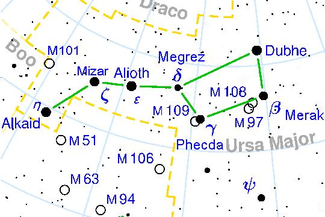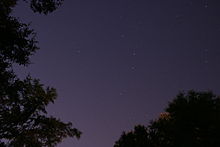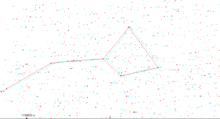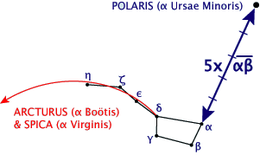- Big Dipper
-
This article is about the asterism. For other uses, see Big Dipper (disambiguation).
The Plough, also known as the Big Dipper or the Saptarishi (after the seven rishis), is an asterism of seven stars that has been recognized as a distinct grouping in many cultures from time immemorial. The component stars are the seven brightest of the formal constellation Ursa Major.
The Plough is significant because the North Star (Polaris), the current northern pole star on Earth, can be found using it. Polaris is part of the "Little Dipper", Ursa Minor.
Contents
Names and lore
Asia
Part of a series on Translation Types Language interpretation
Legal · Literal · TechnicalTechniques Computer-assisted
Machine · Subtitling
PosteditingRelated topics Transcription
Transliteration
Language barrier
Video Relay Service
Telephone interpretingv · In Hindu astronomy, it is referred to as Sapta Rishi, meaning the "Seven (Great) Sages".
Throughout eastern Asia, these stars compose the Northern Dipper. They are colloquially known as the "Seven Stars of the Northern Dipper":
The seven stars are very important in Taoist astrology. Sometimes there are said to be nine stars — besides the seven visible stars, two invisible "attendant" stars, one on either side of the star Alkaid. Legend has it that there used to be 9 stars (北斗九星) but 2 had since faded and that those who can see the 2 unseen stars will lead a long life. The Goddess Doumu is said to have given birth to the nine stars which make up the constellation.
Buruj Biduk (The Ladle) is the formation's name in Malaysia. In Mongolia, it is known as the Seven Gods (Долоон бурхан). In parts of rural India, it is known as the Samantha formation. An Arabian story has the four stars of the Plough's bowl as a coffin, with the three stars in the handle as mourners, following it.
Europe
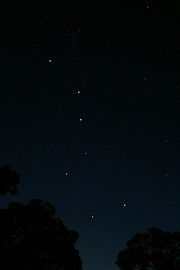 The Big Dipper seen from Kauai.
The Big Dipper seen from Kauai.
In both Ireland and Great Britain, this pattern is known as the Plough or sometimes the Saucepan.[citation needed] It is also occasionally referred to as the Butcher's Cleaver in northern England. In Ireland the figure is sometimes called the Starry Plough; the symbol of the Starry Plough has been used as a political symbol by Irish Republican and left wing movements.
Known as Charles his waine in some areas of England, the Plough was formerly called by the old name Charles' Wain[1] ("wain" meaning "wagon," and derived from the still older Carlswæn), as it still is in Scandinavia, Karlavagnen, Karlsvogna, or Karlsvognen. In the northeast of England it is sometimes known as Charlie's Waggon. A folk etymology holds that it was named after Charlemagne, but this common Germanic name meant the men's wagon (the churls' wagon), in contrast to the women's wagon (the Little Dipper).[2][3] An older Odin's Wain may have preceded these Nordic designations.[1] Similarly, in Romanian and most Slavic languages it is known as "the Great Wagon", as opposed to "the Small Wagon," the Little Dipper. In German it is called Großer Wagen (Great Cart).
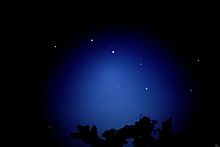 The Big Dipper seen from Berlin (Germany) in June 2011.
The Big Dipper seen from Berlin (Germany) in June 2011.
In Dutch, its official name is Grote Beer ( Big Bear), but often called Steelpannetje (saucepan), because of its resemblance to the utensil. In Finland the figure is known as Otava and widely used as a cultural symbol. In Finnish dialects, the word otava means a 'salmon net', but this word is largely obsolete in modern Finnish.
In Hungary, it is commonly called Göncölszekér ("Göncöl's cart") after a figure in Hungarian mythology, a táltos who carried medicines in his cart that could cure any disease.[4]
These seven stars (septentriones, from the phrase septem triōnēs, meaning "seven plough oxen"[5]) are the origin of the Latin word septentriōnēs meaning "north" and now found as the adjective septentrional (northern) in English, French, Italian, Portuguese and Spanish. This etymology goes back to a passage in Varro (Marcus Terentius) who explains that triōn- (a word not attested elsewhere) means "plough ox" and derives the form from terō, one of whose meanings is "thresh grain by rubbing". The derivation is acceptable (Latin short vowels often syncopate before -r- in medial syllables), but the meaning, if Varro is right about the root derivation, is surely "threshing ox", as the seven stars (oxen) perpetually wheel about the pole star like oxen on a threshing floor. A different etymology appeals to *septem astr-iōn- "seven stars" (aster-), which is not obviously wrong (if lacking poetic inspiration), but the development of *-nstr- to -ntr- is not without problems.
North America
In the English speaking regions of North America (Canada and the United States) the Plough is known as the Big Dipper because the major stars can be seen to follow the rough outline of a large ladle or dipper. This figuration appears to be derived originally from Africa, where it was sometimes seen as a drinking gourd. In the 19th century, runaway slaves would "follow the Drinking Gourd" to the north and freedom.
A widespread American Indian figuration had the bowl as a bear. Some groups considered the handle to be three cubs following their mother, while others pictured three hunters tracking the bear. (For example, see Abenaki mythology.) The Dipper appears on some Tribal flags, while the flag of the state of Alaska features a stylized Big Dipper and North Star. The Anishinaabe or Ojibway First Nation know the Big Dipper as Ojig-anang or the Fisher Star (after the fisher cat).
Stars
Within Ursa Major the stars of the Big Dipper have Bayer designations in consecutive Greek alphabetical order from the bowl to the handle.
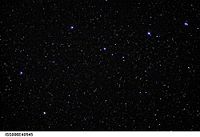

The Big Dipper's bowl and part of the handle photographed from the International Space Station.
Mizar and Alcor are at the upper right.Proper
NameBayer
DesignationApparent
MagnitudeDistance
(L Yrs)Dubhe α UMa 1.8 124 Merak β UMa 2.4 79 Phecda γ UMa 2.4 84 Megrez δ UMa 3.3 81 Alioth ε UMa 1.8 81 Mizar ζ UMa 2.1 78 Alkaid η UMa 1.9 101 In the same line of sight as Mizar, but three light-years beyond it, is the star Alcor (80 UMa). Together they are known as the Horse and Rider. At fourth magnitude, Alcor would normally be relatively easy to see with the unaided eye, but its proximity to Mizar renders it more difficult to resolve, and it has served as a traditional test of sight. Mizar itself has four components and thus enjoys the distinction of being part of an optical binary as well as being the first-discovered telescopic binary (1617) and the first-discovered spectroscopic binary (1889).
Five of the stars of the Big Dipper are at the core of the Ursa Major Moving Group. The two at the ends, Dubhe and Alkaid, are not part of the swarm, and are moving in the opposite direction. Relative to the central five, they are moving down and to the right in the map. This will slowly change the Dipper's shape, with the bowl opening up and the handle becoming more bent. In 50,000 years the Dipper will no longer exist as we know it, but be re-formed into a new Dipper facing the opposite way. The stars Alkaid to Phecda will then constitute the bowl, while Phecda, Merak, and Dubhe will be the handle!
Guidepost
Not only are the stars in the Big Dipper easily found themselves, they may also be used as guides to yet other stars. Thus it is often the starting point for introducing Northern Hemisphere beginners to the night sky:
- Polaris, the North Star, is found by imagining a line from Merak (β) to Dubhe (α) and then extending it for five times the distance between the two Pointers.
- Extending a line from Megrez (δ) to Phecda (γ), on the inside of the bowl, leads to Regulus (α Leonis) and Alphard (α Hydrae). A mnemonic for this is "A hole in the bowl will leak on Leo."
- Crossing the top of the bowl from Megrez (δ) to Dubhe (α) takes one in the direction of Capella (α Aurigae). A mnemonic for this is "Cap to Capella."
- Castor (α Geminorum) is reached by imagining a diagonal line from Megrez (δ) to Merak (β) and then extending it for approximately five times that distance.
- By following the curve of the handle from Alioth (ε) to Mizar (ζ) to Alkaid (η), one reaches Arcturus (α Boötis) and Spica (α Virginis). A mnemonic for this is "Arc to Arcturus then speed to Spica."
Additionally, the Dipper may be used as a guide to telescopic objects:
- The approximate location of the Hubble Deep Field can be found by following a line from Phecda (γ) to Megrez (δ) and continuing on for the same distance again.
- Crossing the bowl diagonally from Phecda (γ) to Dubhe (α) and proceeding onward for a similar stretch leads to the bright galaxy pair M81 and M82.
- Two spectacular spiral galaxies flank Alkaid (η), the Pinwheel (M101). to the north, and the Whirlpool (M51), to the south.
- Projecting a line from Alkaid through the pole star will point to Cassiopeia and hence the cluster known as the Seven Sisters or Pleiades,
Cultural associations
The Bible refers to it as "the seven stars" (Amos 5:8).[6]
Book XVIII of Homer's Iliad mentions it as "the Bear, which men also call the Wain." [7]
In Tolkien's Middle-earth mythos, it is called the Valacirca (Sickle of the Valar), the sign of Hope signifying doom for Evil, while in T.A. Barron's Great Tree of Avalon series, it is called the Wizard's Staff, symbolizing Merlin's staff.
It is a prominent symbol in the Fist of the North Star manga/anime series; Kenshiro, has scars on his chest in the Big Dipper's configuration. It is identified as an omen: "When the great bear appears, violence will follow."
In addition to appearing on the flags of political entities, the Dipper has also been used in corporate logos.[8]
See also
- Ursa Major, the constellation of which the Big Dipper is a part
- Little Dipper
Notes
- ^ a b Star Names: Their Lore and Meaning – "Ursa Major", by Richard Hinckley Allen
- ^ "150 ord och begrepp inom astronomisk navigation" by Gösta Bågenholm: "Som pendang till Karlavagnen kallas Lilla björn (latin Ursæ Minoris) för kvinnovagnen..." — as an appendix to the Mens Wagon the Little bear is called the Womens wagon
- ^ Svensk etymologisk ordbok (1922), by Elof Hellquist, entry Karlavagnen: "I stället sammansatt" ... – "Instead composed from the appellative karl [man] in opposition to Icelandic kvennavagn [women's wagon]"
- ^ In order not to be confused with the Little Dipper, our asterism is also called Nagy Göncöl or "Big Göncöl".
- ^ Merriam-Webster
- ^ As per the King James Version. Other translations have "the Pleiades," which also has seven stars visible to the naked eye.]
- ^ Iliad
- ^ Allen P. Adamson; Martin Sorrell (2007). Brandsimple: how the best brands keep it simple and succeed. Palgrave Macmillan. p. 101. ISBN 9781403984906. For an example see Iridium Satellite LLC.
Categories:- Ursa Major constellation
- Astronomical asterisms
Wikimedia Foundation. 2010.
Look at other dictionaries:
Big Dipper — (Pleasure Beach, Blackpool) Pour les articles homonymes, voir Big Dipper (homonymie). Big Dipper … Wikipédia en Français
Big Dipper — Amer.Eng. name for the seven star asterism (known in England as the plough; see CHARLES S WAIN (Cf. Charles s Wain)) in the constellation Ursa Major, first attested 1833 as simply the Dipper (sometimes Great Dipper, its companion constellation… … Etymology dictionary
Big Dipper — ist der Name mehrerer Achterbahnen: Big Dipper (Blackpool) Big Dipper (Geauga Lake) Diese Seite ist eine Begriffsklärung zur Unterscheidung mehrerer mit demselben Wort bezeichneter Begriffe … Deutsch Wikipedia
big dipper — n 1.) BrE old fashioned a small railway in a ↑funfair, with steep slopes and sharp curves to give an exciting ride 2.) the Big Dipper AmE a group of seven bright stars seen only from northern parts of the world British Equivalent: the Plough … Dictionary of contemporary English
big dipper — ► NOUN 1) Brit. a roller coaster. 2) (the Big Dipper) N. Amer. a prominent formation of seven stars in the constellation Ursa Major (the Great Bear) … English terms dictionary
Big Dipper — ☆ Big Dipper n. a dipper shaped group of stars in the constellation Ursa Major … English World dictionary
big dipper — big dippers N COUNT A big dipper is a fairground ride that carries people up and down steep slopes on a narrow railway at high speed. [BRIT] Syn: roller coaster … English dictionary
big dipper — UK / US noun [countable] Word forms big dipper : singular big dipper plural big dippers British a large structure like a small railway with many sharp turns and steep hills that you ride on for fun and excitement at a funfair … English dictionary
big dipper — noun 1》 Brit. a roller coaster. 2》 (the Big Dipper) North American term for plough (in sense 2) … English new terms dictionary
big dipper — noun (C) 1 a small railway in a funfair, with steep slopes and sharp curves to give an exciting ride 2 the Big Dipper AmE a group of seven bright stars seen only from northern parts of the world; the plough 1 (3) BrE … Longman dictionary of contemporary English
18+© Academic, 2000-2024- Contact us: Technical Support, Advertising
Dictionaries export, created on PHP, Joomla, Drupal, WordPress, MODx.Share the article and excerpts
Big Dipper
- Big Dipper
-
This article is about the asterism. For other uses, see Big Dipper (disambiguation).
The Plough, also known as the Big Dipper or the Saptarishi (after the seven rishis), is an asterism of seven stars that has been recognized as a distinct grouping in many cultures from time immemorial. The component stars are the seven brightest of the formal constellation Ursa Major.
The Plough is significant because the North Star (Polaris), the current northern pole star on Earth, can be found using it. Polaris is part of the "Little Dipper", Ursa Minor.
Contents
Names and lore
Asia
Part of a series on Translation Types Language interpretation
Legal · Literal · TechnicalTechniques Computer-assisted
Machine · Subtitling
PosteditingRelated topics Transcription
Transliteration
Language barrier
Video Relay Service
Telephone interpreting

